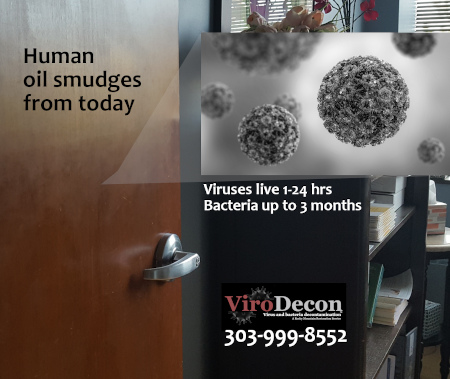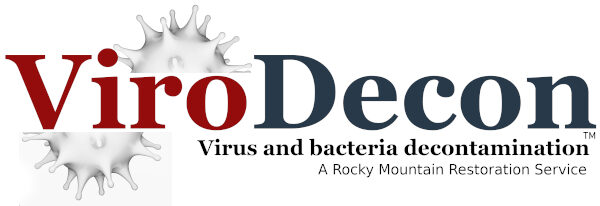Fogging is a method for disinfection and deodorizing. The general idea is you vaporize a chemical solution which fills the air in a confined space. The moisture droplets condense on almost every surface and can disinfect. Fogging is fast, cheaper than wet disinfection and often adequate for commercial needs unless a known infected person has contaminated your space, then we go to level 2 or 3 decontamination.

Why fog?
- Normal office cleaning service or in-house employees disinfect only 5-20% of surface area, and studies show that in hospitals the rate is still low at 50% for patient care rooms. It is important that daily cleaning crews hit “high-touch” surfaces like rails, doorknobs, desktops, doors.
- Disinfecting by wiping surfaces is expensive as it takes hours to clean an average office
- Fogging is the first easy and lowest cost option for disinfection of entire rooms, warehouse goods and vehicles
Not all fogging is the same:
- Not all solutions kill all viruses or germs, the EPA tests and certifies if a given solution will work against a pathogen
- Exposure time matters in disinfection, not enough density of fog is less effective
- It matters if the fogging is electrostatic, electrostatic fogging puts a positive or negative charge on particles and the dispersed droplets spread out more evenly and seek out negative or neutrally charged surfaces. This helps the fog coat surfaces and disinfect very efficiently.
DIY :
Off the shelf pesticide and germ fogging cans exist and are useful for non-professional applications. They waste a lot of material that drifts to the floor as they are not electrostatic. Many common foggers leave a nasty film on windows, computer screens, etc so choosing the right product for the use is important.

Professional fogging:
Professional fogging systems are designed for quickly covering a large area. Most are designed for an operator to walk through a space and direct the fog at objects or create vortices in the air which distribute the fog hard to reach high spots. The electrostatic systems quickly cover every part, even spots like under chairs and through gaps in messy stacks of items on bookcases or desk tops.
The operator of a system with anti-pathogen solutions should be compliant with OSHA regulations and have a protective suit, mask, and gloves. The mask must be equipped with the right type of filters to protect the operator from very active solutions. The solutions we use at ViroDecon are often bio-friendly and don’t leave a film, however there is a period of 10 minutes or more where the solution is dangerous to breath.
There are many solutions used for different applications like mold remediation (killing mold spores in the air and on surfaces), or virus and bacterial decontamination. At ViroDecon we comply with regulations and do not mix solutions in our equipment, certain gear is tasked for certain types of jobs. In a market of non-certified Denver/Boulder cleaning services we see plenty of cost cutting and bad practices by contractors which mix solutions or use non-approved solutions because they are cheap. With a long history of mold remediation where we must pass tests, we value quality work.
When fogging is not enough:
While fogging is the go-to for preventative services in healthcare and commercial buildings, and is our Level 1 service at ViroDecon, there are times when fogging alone won’t be enough:
- When you know that someone with ebola, coronavirus COVID-19, etc. was in the space. We then resort to wet decontamination instead of fogging.
- When there is blood, tissue, feces and other material. Fogging only disinfects surfaces and has limited ability to penetrate materials.
In the above situation we go to Level 2 service which involves “wet decontamination” or misting/spraying liquid directly onto surfaces. This method is recommended by the CDC in these situations.
Things you don’t want to fog:
- Sensitive equipment that uses precise optics, precise atmospheric sensors, and similar should not be fogged.
- Plants, but it depends on the type of fogging being done, fogging was first done in agriculture to disperse pesticides.
- Animals
Common computers and office equipment can be fogged. In fact it’s the best way to disinfect the spaces between keys in a keyboard, or in nooks and spaces.
If you have sensitive machinery we will use wet decontamination directed away from the machines. We sometimes use UVC lamps to decontaminate machines that cannot be fogged or misted. Please let us know about sensitive areas in your building and we will adjust our system to accommodate.
